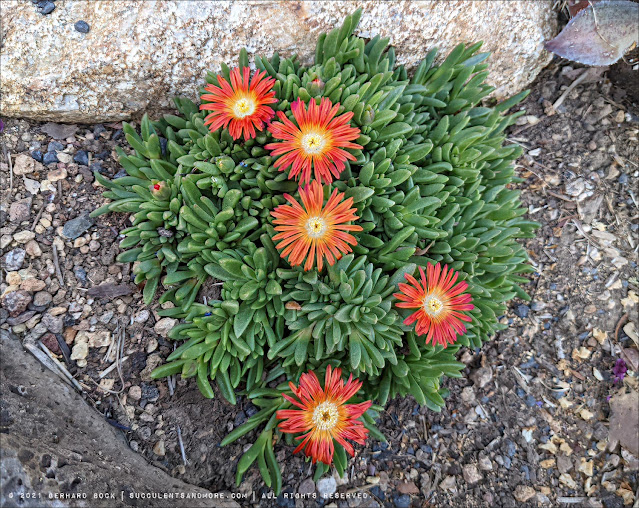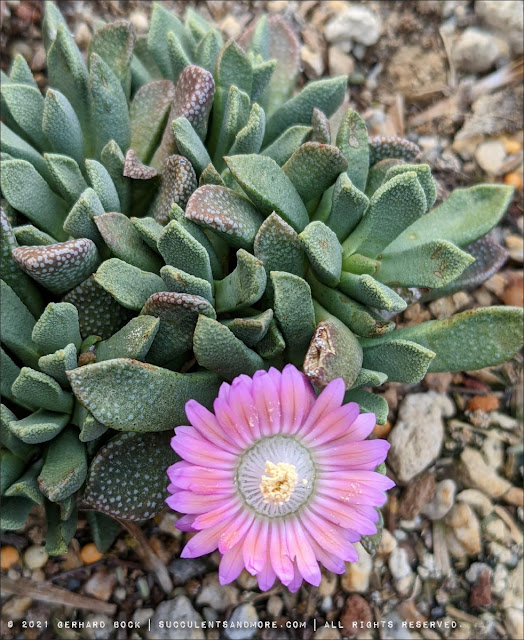One of my 2021 garden resolutions was to pay more attention to smaller plants that may not stand out as much but are so essential in knitting everything together. Except they do stand out at certain times of the year, especially when they're in bloom.
A prime example are ice plants, typically called “mesembs” by collectors because they were once in the Mesembryanthemaceae family (now they're in the Aizoaceae). For the most part, their leaves are fairly unremarkable, although I would argue that it's exactly that quality that makes them so good at creating “neutral” spaces for your eyes to rest on. But when they're in flower, they're impossible to miss.
 |
| Thelocactus rinconensis var. lophothele (Saltillo, Coahuila, Mexico) |
 |
| Thelocactus rinconensis var. lophothele |
 |
| Thelocactus rinconensis (Coahuila and Nuevo León, Mexico) |
 |
| Thelocactus rinconensis |
 |
| Mistletoe cactus (Rhipsalis baccifera) flowering quite profusely this year. I got several small cuttings from Loree 'the danger garden' Bohl in 2019, stuck them in a pot, and here we are! The flowers are just ¼" in size. |
A few more miscellaneous examples:
 |
| Dymondia margaretae, a dense low-growing groundcover from South Africa periodically adorned with simply yellow flowers. The leaves look like they have white margins, but that's actually the silvery underside showing. |
 |
| Lady tulip (Tulipa clusiana), a species tulip that doesn't need much winter chill to survive and is therefore reliably perennial in our climate. It's native to Afghanistan, Iran, Iraq, Pakistan and the western Himalayas. |
And finally a couple of small succulents that caught my eye because of their leaves:
 |
| Dudleya greenei, a smaller clumping species from the Channel Islands off the coast of Santa Barbara. Each rosette is maybe 2½" in diameter. |
 |
| Aloe 'Wily Coyotee', a Karin Zimmerman hybrid sold through the Huntington's International Succulent Introduction program. Like all of Karin Zimmerman's aloe creations, this one is diminutive in size, maybe 4" across. |
I'm working on finding better ways to display smaller plants—like the Karin Zimmerman aloes I've collected—so I can look at them up close. Stay tuned for more details.
© Gerhard Bock, 2021. All rights reserved. No part of the materials available through www.succulentsandmore.com may be copied, photocopied, reproduced, translated or reduced to any electronic medium or machine-readable form, in whole or in part, without prior written consent of Gerhard Bock. Any other reproduction in any form without the permission of Gerhard Bock is prohibited. All materials contained on this site are protected by United States and international copyright law and may not be reproduced, distributed, transmitted, displayed, published or broadcast without the prior written permission of Gerhard Bock. If you are reading this post on a website other than www.succulentsandmore.com, please be advised that that site is using my content without my permission. Any unauthorized use will be reported.




















You've collected some choice smallish rock garden plants -- I'm taking notes...
ReplyDeleteI have high hopes for these. They sailed through the winter. Summer will be the ultimate test.
DeleteAll these are blooming in your garden right now? Practically a blogger's bloom day post.
ReplyDeleteI find a perfect combination of interesting leaf and showy flower in Delosperma 'Granita Orange', where the blooms are very vibrant hues and it has cool tight green foliage, and also in Nananthus pole-evansii: amazing flower and foliage.
I'm waiting to see what you'll come up with for the "up close" display.
Yes, all of these are flowering right now.
Delete'Granita Orange' has been a wonderful surprise. There's also a 'Granita Raspberry' (see here), but I'm partial to the orange.
An excellent survey of some very attractive small plants. The ×Aloinanthus 'Opera Mauve' especially!
ReplyDeleteWill any of those hold up to your summer sun? I'm researching small plants for the front slope that do as you say, "knit things together", but growing conditions there are tough, so tough plants mandatory.
Some of them will be fine in the summer heat (check out Ruschia lineolata; San Marcos Growers says it's handled 120°F with no damage).
DeleteFrom my experience, Delosperma is OK too, but needs regular water to look good.
I don't really know about Aloinopsis, Nananthus, etc. but they do come from hot and dry climates...
I love the 'Wily Coyote' Aloe and will have to check on the 2021 ISI offerings. I'd like to trial some low-growing succulent groundcover alternatives to the rampant lavender-flowered ice plant (maybe Delosperma cooperi) that came with the garden. Aloinopsis villetii is particularly striking.
ReplyDeleteDelosperma cooperi can be a big of a thug but takes well to shearing.
DeleteAloe 'Wily Coyotee' was was 2016 ISI offering but is still available, like most Karen Zimmerman hybrids. Just go through the catalog HERE. The 2021 offering should be released in June.
I have to say my favorite is Aloinopsis spathulata. Love those leaves! I hear you on the knit-together thing. I am carrying around a list of small low plants to upgrade the edges of the garden beds . And in fact thiw weekend I dug out more lawn around the perimeter of the 'Agave Meadow' to make room for more .
ReplyDeleteHERE is a good photo of multiple clumps of Aloinopsis spathulata that will soon merge into a carpet.
DeleteI bought several pots of Sedum dasyphyllum 'Himalayan Skies' at the UC Davis Arboretum fall plant sale last year and it's been a good "knitter." I divided each 4" plant into several chunks and they took off.
Don’t you just love it when these small plants make their presence known with their showy blooms? Great selection!
ReplyDeleteI love being surprised like that!
DeleteWow! Your Rhipsalis baccifera is insane! It clearly loves your climate.
ReplyDeleteI love the idea of having a piece of the danger garden growing in my garden.
DeleteEverything looks fabulous. Especially love the iris and the rhipsalis.
ReplyDelete